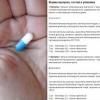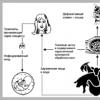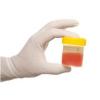Deciphering the analysis for chlamydia in the blood. Anti-Chlamydia tr. Chlamydia iga igm
Antibodies of the IgA class to the causative agent of urogenital chlamydia (Chlamydia trachomatis) are specific immunoglobulins produced in the human body during the period of pronounced clinical manifestations of urogenital chlamydia. They are a serological marker of this disease.
Russian synonyms
Antibodies of class IgA to Chlamydia trachomatis, class A immunoglobulins to the causative agent of chlamydia.
English synonyms
Anti-Chlamydia tr.-IgA, Chlamydia tr. Antibodies, IgA.
Research method
Enzyme immunoassay (ELISA).
What biomaterial can be used for research?
Venous blood.
How to properly prepare for research?
Do not smoke for 30 minutes before donating blood.
General information about the study
Chlamydia trachomatis, IgA, are antibodies (immunoglobulins, immunity factors) that are produced during chlamydial infection in the acute period of its development.
Chlamydial infection, or chlamydia, is a collection of diseases that are caused by microorganisms from the genus Chlamydia.
The life cycle of chlamydia consists of two phases. The first phase is extracellular, when chlamydia are in a spore-like form and are called elementary bodies (they are insensitive to antibiotics). After penetrating inside, chlamydia cells turn into reticular bodies - a biological form that actively reproduces; during this period, chlamydia are sensitive to antibiotic therapy. This feature explains the tendency of this type of infection to a long chronic course.
Four types of chlamydia cause diseases in humans, one of them is Chlamydia trachomatis . This species has several varieties (serotypes), each of which is prone to damage to a particular organ. Chlamydia trachomatis infects certain types of cells that cover the lining of the urethra, the inside of the cervix in women, the back of the throat, the lining of the rectum, the conjunctiva of the eyes, and the respiratory tract in children during their first months of life.
Infection with chlamydia occurs as a result of direct contact of the mucous membranes with the pathogen, usually during unprotected intercourse. A child can become infected during the passage of the birth canal.
The incubation period from the moment of infection to the appearance of the first symptoms of the disease lasts from 7 to 20 days or more. Sometimes visible signs do not develop. This is either an asymptomatic carriage, or cases when the symptoms of the disease are not noticeable, but the structures and functions of the tissues are slowly impaired (persistent form of the disease).
In women, chlamydial infection most often occurs in the form of inflammation of the cervical canal, from where it passes into the uterine cavity and fallopian tubes. Inflammation of the fallopian tubes (salpingitis) is the most common complication of chlamydia and can lead to blocked fallopian tubes and eventually infertility or tubal (ectopic) pregnancy. A feature of chlamydia of the uterine appendages is a tendency to the absence of specific symptoms of the disease and a long course. In some cases, the infection spreads higher to the abdominal organs.
In men, chlamydia can be present as an inflammation of the urethra (urethritis), vas deferens (epididymitis). In some cases, the prostate gland becomes inflamed (prostatitis).
Between 5 and 20% of pregnant women have chlamydial infection of the cervical canal. Approximately half of the children who are born to them become infected during childbirth. Half of infected children develop chlamydial conjunctivitis, 10% of children develop pneumonia.
During sexual intercourse, chlamydial infection can cause an acute inflammatory disease - lymphogranuloma venereum. As the disease progresses, the lymph nodes increase and well-being is disturbed. In the future, there may be complications associated with changes in the genitals and rectum.
Infection with chlamydia is accompanied by the appearance of antibodies (immunoglobulins) in the body: IgM, IgA, IgG. The production of each of them is associated with a certain stage of the infectious process, so that their appearance and quantity in the blood can be used to judge the stage of the disease.
Antibodies of the IgA class serve as indicators of acute or exacerbation of chronic infection. They provide local immunity in the mucous membranes, where their maximum concentration is observed. This prevents a wider spread of chlamydia in the body. IgA are detected in the blood 10-15 days after the initial introduction of Chlamydia trachomatis. In the future, after a certain time, their concentration decreases. If the disease becomes chronic, their level remains high for a long time. The lgA titer increases with an exacerbation of a chronic process or with re-infection, but decreases after effective therapy.
What is research used for?
- To determine the stage of a disease resulting from infection with chlamydia that requires immediate treatment.
- To decide on the advisability of antibiotic therapy.
- To evaluate the effectiveness of antibiotic treatment and decide whether to continue/stop treatment (or change it).
- To assess the risk of infection of the child during pregnancy (or childbirth) with an inflammatory disease of the genital organs and / or urinary tract in the mother.
When is the study scheduled?
- With symptoms of chlamydial infection. In women, this is discharge from the genital tract, burning, itching in the genital area, pain in the lower abdomen. In men - burning during urination, discharge from the urethra, pain, itching in the genital area.
- In combination with other studies to determine the causes of infertility.
- With symptoms of conjunctivitis and / or pneumonia in a newborn.
- When it is required to establish the stage of chlamydial infection.
- If during antibiotic therapy it is necessary to determine its effectiveness.
- If during pregnancy an inflammatory disease of the genital organs and urinary tract appeared.
What do the results mean?
Reference values
Result: negative.
CP (positivity ratio): 0 - 0.99.
The titer is determined upon receipt of a positive test result and should be used solely to evaluate the results of the study in dynamics (when conducting a re-examination after 2-4 weeks), but not to make a diagnosis based on a single analysis result.
The results of the analysis indicate the presence or absence of an acute infectious process caused by chlamydia, without specifying whether the infection has occurred recently or whether this is an exacerbation of a chronic disease.
Positive result:
- infection with chlamydia occurred more than two weeks ago, the process is in an acute stage;
- chronic chlamydial infection in the acute stage;
- re-infection with chlamydia (the process is in the acute phase);
- the likelihood of infection of the fetus during pregnancy or during childbirth.
Negative result:
- no acute illness associated with chlamydial infection;
- infection occurred less than two weeks ago;
- the likelihood of infection of the fetus during pregnancy or during childbirth is low.
What can influence the result?
Antibodies to chlamydia - cells produced by the immune system in response to the penetration of the infectious agent. The higher the body's defenses, the faster the capture and destruction of foreign bodies.
Despite the fact that the norms of antibodies to chlamydia can be found in medical reference books, each patient should understand that a qualified specialist should be involved in deciphering the results of the analysis. Don't try to do this on your own. It is not necessary to draw conclusions about the presence of chlamydia on the basis of the data obtained. Every doctor knows that antibody titers are a variable value.
 Their different types are detected in various forms of the disease. Therefore, the expression "found chlamydia" is incorrect. A positive result of an antibody test should not be a reason for the use of a particular drug. Venous blood serves as a material for research.
Their different types are detected in various forms of the disease. Therefore, the expression "found chlamydia" is incorrect. A positive result of an antibody test should not be a reason for the use of a particular drug. Venous blood serves as a material for research.
The presence of immunoglobulins can be determined by ELISA, the accuracy of which is close to 90%.
Antibody types
To determine the stage and form of the disease, as well as the selection of the most effective treatment regimen, the doctor analyzes several indicators:

Antibodies to IgA can be detected as early as 2 weeks after infection. In the following months, their titer constantly increases, however, with proper therapy, a gradual decrease is observed until it reaches normal values. If during the treatment period this indicator remains unchanged, we are talking about the transition of chlamydia into a chronic form. If the result is negative, the antibody test is repeated after 2 weeks. This method is considered auxiliary, it cannot be used to make a final diagnosis.
Antibodies of the IgM class appear in the body when chlamydia begins to actively reproduce and the disease becomes acute. Their appearance indicates that the immune system needs support to fight the bacteria. Not without the use of antibiotics. Regardless of the amount, these antibodies will not be able to destroy the infection.
 Antibodies to chlamydia IgM appear about 3 weeks after infection. A further decrease in titer does not indicate recovery. A positive and weakly positive test result during pregnancy indicates the possibility of intrauterine infection of the fetus.
Antibodies to chlamydia IgM appear about 3 weeks after infection. A further decrease in titer does not indicate recovery. A positive and weakly positive test result during pregnancy indicates the possibility of intrauterine infection of the fetus.
Anti chlamydia trachomatis IgG are detected a few weeks after infection and remain in the body forever. If a patient has had chlamydia at least once in his life, a small titer will be present throughout his life. The result of the analysis for antibodies to chlamydia trachomatis IgG positive does not give an idea of the form in which the infection proceeds. Blood for immunoglobulins of this class is recommended to be examined several times. Diagnosis of chlamydia should include more informative methods.
Deciphering the results
When interpreting the results of the analysis for chlamydia, specialists use the positivity coefficient:

To determine the stage of the pathological process, it is necessary to analyze the amount of class M immunoglobulins. Additionally, an analysis of a smear from the urethra or vagina is prescribed. The combination of these methods allows you to establish the correct diagnosis. Antibodies in the body of a child can be detected if his parents had chlamydia. Especially often occurs intrauterine infection. Analysis should be done when there are signs of chlamydial conjunctivitis, otitis or laryngitis.

Intrauterine infection is indicated by the presence of class G immunoglobulins in the absence of others. A negative test result in a newborn does not mean that he does not have chlamydia. If the infection occurred at the time of birth, antibodies in the blood appear only for 3-4 weeks of life. During this period, a re-examination is recommended.
It is impossible to make an accurate diagnosis based on the detection of antibodies during pregnancy. During this period, the analysis very often gives false positive results. The rate of antibodies to chlamydia largely depends on the duration of pregnancy. When deciphering the conclusion, the specialist must take this indicator into account. The use of antibacterial drugs before an accurate diagnosis is unacceptable.
Antibodies to chlamydia can be detected in a completely healthy person. This is explained by the fact that they are similar to the immunoglobulins produced by influenza and SARS - diseases that have visited almost every inhabitant of our planet. In order not to carry out treatment in vain, a PCR study is prescribed.
If IgG antibodies are positive in the blood test, then chlamydia has settled in the body. From the infection caused by these microorganisms, no one is immune. Chlamydia is transmitted in two ways: contact-household and sexual, affects the mucous membranes. Chlamydia is dangerous complications in adults, among which are the development of arthritis, pneumonia and others. Therefore, the detection of chlamydia is of great importance.
- Sexual - during unprotected sexual contact;
- Contact-household - when using objects infected with pathogenic microflora.
In the process of infection and the development of the disease, the mucous membrane thickens. It is replaced by connective tissue. In most cases, this process, if left untreated, provokes the development of infertility. With the development of pneumonia, metaplasia of the lung tissue occurs.
In order to diagnose the presence of Chlamydia trachomatis, a blood test is performed. It allows you to detect antibodies to chlamydia. In the presence of a pathogen, there is an increase in the number of antibodies (anti-chlamydia) - IgA, IgM, IgG. Diagnostics can be prescribed by a general practitioner, internist, obstetrician-gynecologist, pediatrician, neonatologist and infectious disease specialist.
Infection process
The life cycle of the pathogen is divided into two periods. During the first, the pathogenic microflora is outside the cells, representing spores. They are resistant to antibiotic therapy. After entering the cell, the viruses become reticular bodies. At this stage, chlamydia can be treated with antibacterial drugs.
Classification of antibodies
Antibodies are proteins that are produced by the body's defense structures. They are classified into the following classes:
IgM
The appearance of antibodies of the IgM type occurs immediately after infection. IgM antibodies can be detected in the acute course of the disease. This period begins from 4 to 5 days from the moment the pathogen enters the human body. Gradually, the antibody titer decreases. After three months they disappear.

IgA
IgA antibodies can be detected after 7 days of illness. By this time, sufficient reproduction of pathogenic microflora occurs. The infected should limit contact in order to prevent the spread of infection. With the necessary therapy, the amount of IgA antibodies decreases closer to 4 months from the moment of infection. If there is a constant titer of antibodies in the blood, the diagnosis of the transition of the disease to a chronic form or the absence of immunity is confirmed.
IgG
A high titer of the IgG class is detected after 2-3 weeks from the fact of infection. These antibodies are produced by the body for a long time (several years). Therefore, after a chlamydial infection, the amount of antibodies of this class will always be increased in a blood test. When carrying a child, antibodies to chlamydia trachomatis IgG penetrate the placental barrier. The fetus develops immunity to the corresponding disease.
Research and decoding
For the purpose of conducting research, blood, urine, and the contents of a smear can act as biological material. Blood is taken from a vein in the morning before meals. On the eve of the examination, they follow a diet, limiting the use of marinades, fried foods. Eliminate alcoholic beverages from the diet.
When examining urine the day before the test, they refuse intimate life. For the study, it is necessary to collect biomaterial in the morning. When conducting an analysis using a smear, sexual intercourse is excluded three days before the examination. The biomaterial is taken immediately after the end of menstrual bleeding on the first day.
The collection of analyzes for the study is carried out by a laboratory assistant. For medical manipulations, special equipment and reagents are used. After receiving the results of the study, a visit to the doctor who sent for the examination follows. He analyzes the results and prescribes therapy.
In some cases, with a positive result, it is necessary to pass the analysis again. This will avoid mistakes in treatment. Therapy for chlamydia is based on the use of antibiotics. Additionally stimulate the immune system.
What are the results
Results after examination for the presence of chlamydia can be of two poles: positive or negative. The negative answer says:
- About the absence of an infectious process (IgA and IgM antibodies were not detected);
- About recovery after the treatment (IgA and IgM antibodies were not detected);
- Less than 14 days have passed since the onset of the infection.
Positive results of a blood test for the presence of chlamydia indicate the development of the disease or an exacerbation of the pathological process a month ago.

The result is positive
In order to confirm the diagnosis, a person is tested for all classes of antibodies. With a positive result, certain types of cells are affected, which are located on the mucous layer of the cervix, pharynx, rectum, and urethra. The respiratory organs (development of pneumonia) and the visual apparatus (inflammation of the mucous membrane) may be affected in children born a few days ago.
A positive result for the presence of Chlamydia trachomatis igg comes in combination with the production of IgM, IgA, IgG antibodies in the body.
In accordance with their titer, the stage of the disease and the effectiveness of specific drugs are determined. The test for IgG antibodies is more accurate after 20 days from the date of infection.
Any infectious disease (pneumonia, arthritis) poses a serious threat to the body of a man and a woman. When identifying the first signs of a pathological process, you should consult a doctor. The presence of IgG antibodies in the analysis is not a reason to despair. The main thing is to consult a doctor for treatment and follow all his prescriptions.
This infection is sexually transmitted, does not appear immediately, causes serious complications, affecting the mucous membranes of the eyes and respiratory organs. May cause infertility.
The disease is detected using special tests that detect antibodies to chlamydia igg.
Chlamydia cannot live independently without the participation of another organism. Moreover, reproduction is possible only inside the host cells.
Infection requires direct contact with the patient. The latent period is about three weeks. Asymptomatic forms of the disease are possible, which greatly complicates the diagnosis.
First of all, the human reproductive system suffers. For a woman, this is an inflammatory process in the cervix, for a man - inflammation of the urinary canal. Untimely treatment of the disease leads to infertility.
If infection occurs during pregnancy, there is a high chance that the baby will be infected during childbirth. Passing through the birth canal, the child can get chlamydial conjunctivitis. If a child becomes infected by inhalation, then in 20 percent of cases pneumonia of the newborn occurs.
Since the pathogen is very resistant to drugs, restoring the health of the baby is very difficult and takes a long time.
Therefore, during pregnancy, the analysis for chlamydia is given twice. If igg on chlamydia is detected during registration, then the pregnant woman is offered therapy aimed at increasing immunity.
If an acute phase of the disease is detected, then it is better to undergo full treatment, since the risks of infection and the development of complications in the child are too high.
How infection occurs

When a virus enters the human body, the immune system immediately reacts to it and produces antibodies. There are three types igg, iga, igm.
Most often, infection occurs as a result of unprotected sexual contact. The likelihood of the disease is very high. It is more than 60%.
Infection is also possible by contact, for example, when using common hygiene items.
Since chlamydia mainly affects the mucous membranes, there is a low percentage of infection by airborne droplets.
Clinical picture

Chlamydia is difficult to diagnose by its manifestations. The nature of the disease at an early stage can be mistaken for a violation of the microflora of the genitourinary system and more serious STDs.
In women and men, the clinical picture is different. Women are characterized by a clear inflammation of the mucous membranes of the vagina and cervix, abundant mucous discharge that does not have a bright unpleasant odor.
Also, at the next stages of the development of the disease, aching, pulling pains in the lower abdomen appear, they intensify before critical days.
If the infection rises higher, we can talk about the appearance of cystitis, frequent urination and pain at the same time. When an infection enters the respiratory tract, the patient often begins to suffer from inflammatory processes in the bronchi and lungs. Frequent bronchitis, pneumonia are diagnosed.
In men, at the initial stage, the disease is more difficult to notice, since there is no discharge from the genitourinary system. The patient complains of recurrent aching pain in the perineum, itching and inflammation of the urethra.
Further, as in women, cystitis develops, prostatitis and inflammation of the respiratory system are possible. A common symptom for both men and women is conjunctivitis. Chlamydia not only damages the mucous membrane of the eye, but also contributes to the formation of rough scars on the cornea.
The disease can also spread to the joints, damaging them. In this case, the patient complains of constant severe pain in the joints, arthritis can be diagnosed.
Chlamydia can occur in parallel with other sexually transmitted infections, complicating them and blurring the clinical picture. Often these infections mix, creating new forms of the disease. Such complicated infections are difficult to treat.
Diagnostics

For diagnosis, a blood test (ifa) is taken, which should show the immunoglobulin produced by the human body, determine the class of antibodies. So, for example, genital chlamydia will show a large amount of igg to chlamydia trachomatis. It should be noted that ELISA is the most reliable test for trachomatis igg
For an accurate diagnosis, a number of studies are offered in addition to a blood test. First of all, it is a smear of the mucous membrane to identify the culture of the pathogen.
Like all chlamydia bacteria, they are susceptible to antibiotics, but it is necessary to choose the most effective drug, for this an analysis is made for sensitivity to drugs.
What does a positive igg test mean?

If analysis revealed igm antibodies to chlamydia, it means that the disease is in the acute phase of development, the patient has recently become infected. The analysis shows the presence of the disease already on the fifth day after contact.
If the test for chlamydia igg in a patient is positive, then we can either talk about a chronic infection, or that the person has been ill not so long ago. Antibodies igg remain in the blood plasma for a long time even after a complete cure.
However, unfortunately, they do not protect against re-infection. So, in advanced conditions, different classes of Chlamydia trachomatis immunoglobulins are found simultaneously in the body.
The doctor determines the exact diagnosis and stage of the disease by the amount (titres). Antibodies to the causative agent chlamydia trachomatis igg are found most often.
Throughout the course of the disease, the patient periodically takes tests, according to which the doctor monitors the change in condition, the effectiveness of treatment.
If at the beginning of the disease a large amount of iga antibodies was found, and after a week it decreased, an increase in Igg antibodies indicates the ineffectiveness of treatment and the transition of chlamydia to the chronic stage.
There is a possibility that a person is a carrier but does not have chlamydia. In this case, Igg antibody titers will also be exceeded. But their value will be small. It will remain stable for many years.
Treatment
Chlamydia responds well to treatment with the right choice of the drug and a set of supportive measures. Treatment can be complicated by the individual characteristics of the organism and the condition of the patient.
So great difficulties arise in the selection of drugs for pregnant women. However, you can not leave the infection and not treat it. The fact is that chlamydia bacteria during the attachment of the fetal egg can provoke an ectopic pregnancy, cause a miscarriage.
Due to infection, premature birth can occur over a long period. Intrauterine infection of a child with the integrity of the membranes is almost impossible. But chlamydia contributes to placental abruption and rupture of the membranes.
If chlamydia is detected at any stage of pregnancy, it is necessary to undergo treatment and constantly monitor the woman's health. Do not be afraid of drugs, their harm is incommensurable with the possible illness of the child.
In normal cases, the treatment of the disease takes two months. Once the diagnosis has been made, the diagnosis should be re-diagnosed. After 3-4 months, antibody titers decrease, we can talk about a complete recovery.
It should be noted that both partners should be treated, even if one of them does not have any symptoms.
Chlamydia causes a number of diseases that have symptoms similar to other pathologies. The infection is transmitted from animals, birds and infected patients.
Chlamydia are resistant to the external environment up to 48 hours. Their death can be achieved by boiling for at least two minutes or by treatment with antiseptic agents.
Types of chlamydia depend on many factors. Diseases such as ornithosis and conjunctivitis occur when Chlamydia psittaci is ingested.
It becomes a source of chlamydial conjunctivitis, nasopharyngitis and otitis media in infants. Men and women suffer from urogenital chlamydia, proctitis, cholecystitis. The infection can cause trachoma.
It affects the respiratory tract, the cardiovascular system suffers. The infection develops various diseases, such as pneumonia, bronchitis, asthma and other pathologies.
Features of chlamydia is that the incubation period proceeds without pronounced symptoms, ranging from seven to twenty days.
Even in modern medicine, which does not stand still, but develops with the times, it is difficult to diagnose chlamydia in the human body.
Diagnosis is carried out by several methods prescribed by a specialist, depending on the gender of the person, age and symptoms with which the patient turned to the doctor.
In our time, the following methods are popular, described below, aimed at identifying a person.
Express or mini tests diagnosed with chlamydia. With their help, you can determine the infection at home.
You can buy such tests at pharmacy kiosks.
The main line of the diagnostic method is the method of immune chromatography.
When chlamydia gets on the test sensitive part, microorganisms combine with antibodies and change the color of the test strip.
The probability that the test will truthfully diagnose the presence of an infection in the body is low, only 15-40%. Therefore, experts do not advise trusting this diagnostic method.
If a person is symptomatic or knows they have come into contact with an infected patient, it is best to seek the help of a professional for a complete evaluation.
(microscopy) is another method that is popular. In the weaker sex of mankind, a smear is examined from the cervix, vagina, urethra during examination by a gynecologist.
A swab is taken by a urologist from the urethra or during prostate examination.
The technique came to us a long time ago, but even today it is popular in medicine. It is easy to perform, quickly and inexpensively for the patient determines the presence of chlamydia in the body.

But, unfortunately, only 15-35% of the method can determine the presence of infection. You should not refuse the procedure, it helps to identify inflammation and diagnose the presence of chlamydial disease.
The presence of leukocytes in a smear in the presence of chlamydia does not always increase, there are times when their number is normal.
 Difficult diagnostic methods include immune fluorescence reaction.
Difficult diagnostic methods include immune fluorescence reaction.
Only a professional laboratory assistant who has access to sophisticated equipment can diagnose in this way.
There are a small number of such specialists today, which does not have the ability to distribute this technique in the provinces and small towns and villages.
Serological method belongs to the standard. It requires special antibodies that bind to chlamydia. After combination they are identified.
The method is simple to perform, the diagnosis takes a short period of time, but the result is not true, often the diagnosis leads to false readings.
It detects not an infection, but antibodies to it, which have three types of IgG, IgM, IgA. Low sensitivity is the main disadvantage of this technique.
Another disadvantage is the detection of infection only 25-35 days after entering the body. Having ease of use, the inexpensive financial side of the technique is still used extremely rarely.
DNA methods
Tests are given when the patient has another infectious pathology, sexually transmitted. In the case when the partner had casual sexual relations, or the partner complains of symptoms similar to chlamydia. Also, if during a routine examination, inflammatory processes of the cervix are revealed.
 To check the presence or absence of chlamydia in the body in the laboratory should be in the antenatal clinic or other medical institution.
To check the presence or absence of chlamydia in the body in the laboratory should be in the antenatal clinic or other medical institution.
Home testing is also possible, but it's important to know that it's only about 25% true on average.
Turning to a specialist in time, each patient has the opportunity to endure the disease without complications and overcome the infection in a short period of time without large financial costs.
What biomaterial can be used for research
Blood from a vein is a biomaterial for research. When taking tests in the laboratory, you should prepare your body so that the result is true.
Blood from a vein should be taken on an empty stomach, since eating food, or even a cup of tea in the morning, will not give a real result.
In order for the tests to be accurate as a result, one should limit, or not eat at all, fatty, fried, smoked foods three days before donating blood from a vein. Eliminate alcohol two weeks before donating blood. It is recommended not to smoke on the day of the test.
To detect the presence of chlamydia, urine can be a biomaterial. When you pass it for a day, you should abandon sexual relations. It is advised to collect the morning portion of urine.
In the case of a smear or scraping, which is another biomaterial, sexual intercourse should be abandoned for three days. It is better not to go to the toilet three hours before delivery. A smear is recommended to be taken on the first day after the end of menstruation. There are cases when the analysis is taken from seminal fluid.
 Attention: in rare cases, material from the joint cavity is used, which is secreted by the synovial membrane.
Attention: in rare cases, material from the joint cavity is used, which is secreted by the synovial membrane.
In this case, the sterility of the joints should be prepared.
Important: 14 days before the delivery of the biomaterial, you can not take antibacterial drugs.
Deciphering the analyzes: norm indicators
A professional laboratory assistant can correctly collect tests for the presence of chlamydia. For this, special equipment and reagents are used.
When the study is completed, the test results are given to patients and they should be consulted by a doctor who will correctly read the result and prescribe the correct treatment.
Chlamydia igm are the first to be determined already on the first day after the bacteria enter the body. After that, anti chlamydia trachomatis iga appear, which signal the progression of the disease.
Often patients ask if chlamydia trachomatis igg is positive, what does it mean.
 Experts advise to seek full clarification from professionals, arguing that positive IgG indicates a chronic form of the disease.
Experts advise to seek full clarification from professionals, arguing that positive IgG indicates a chronic form of the disease.
Antibodies igg to chlamydia trachomatis can be calculated already on the twentieth day of the functioning of the infection in the body.
When the result of anti-chlamydia trachomatis lgg is positive, immediately contact a specialist for competent treatment, otherwise chlamydia will move to other organs and will be able to actively spread.
In the event that antibodies to chlamydia trachomatis igg are positive, you should not give up, the main thing is to follow the correct treatment regimen and choose the right drugs.
Antibodies to igg to chlamydia trachomatis igg transcript must be read correctly by a laboratory assistant or doctor. Studies do not always have the right result the first time. It is advised to take tests several times in order to understand the type and form of the disease.
It is important to know that chlamydia trachomatis igg antibodies show the correct result 20 days after infection.
 A blood test for antibodies to chlamydia c trachomatis igg to momp pgp3 half-titer ifa indicates an active infectious process.
A blood test for antibodies to chlamydia c trachomatis igg to momp pgp3 half-titer ifa indicates an active infectious process.
In this case, at least two types of antibacterial drugs should be used. In parallel, funds are prescribed for the intestines and the immune system.
Chlamydia trachomatis- what it is, if found in the analyzes, can be explained by a gynecologist, urologist, venereologist.
You can find information on the Internet, but every number and letter matters, so professionals will understand different combinations more deeply.
For example, anti chlamydia trachomatis iga can only appear in the human body.
The coefficient of positivity of the norm for chlamydia is 0-0.84. Antibodies to chlamydia in the blood, the norm shows a negative result.
When anti chlamydia trachomatis igg positive, iga negative, it means that the infection is recent and can be cleared from the body in a short period of time by the methods recommended by a professional.
In contact with



















